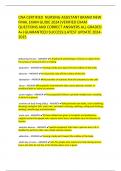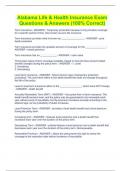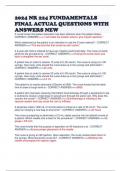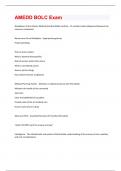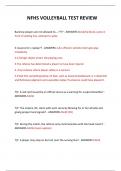CNA CERTIFIED NURSING ASSISTANT BRAND NEW
FINAL EXAM GUIDE 2024|VERIFIED EXAM
QUESTIONS AND CORRECT ANSWERS ALL GRADED
A+|GUARANTEED SUCCESS|LATEST UPDATE 2024-
2025
abdominal thrusts - ANSWER-✔a method of attempting to remove an object from
the airway of someone who is choking
abduction - ANSWER-✔moving a body part away from the midline of the body
abrasion - ANSWER-✔an injury that rubs off the surface of the skin
absorption - ANSWER-✔the transfer of nutrients from the intestines to the cells
abuse - ANSWER-✔purposeful mistreatment that causes physical, mental, or
emotional pain or injury to someone
active neglect - ANSWER-✔the purposeful failure to provide needed care, resulting
in harm to a person
activities of daily living (ADLs) - ANSWER-✔daily personal care tasks, such as bathing;
dressing; caring for skin, nails, hair, and teeth; dressing; toileting; eating and drinking;
walking; transferring; and elimination
acute care - ANSWER-✔24-hour skilled care given in hospitals and ambulatory
surgical centers for people who require short-term, immediate care for illnesses or
injuries
adaptive devices - ANSWER-✔special equipment that helps a person who is ill or
disabled to perform ADLs; also called assistive devices.
adduction - ANSWER-✔moving a body part toward the midline of the body
adult day services - ANSWER-✔care for people who need some help during certain
hours, but who do not live in the facility where care is given
, advance directives - ANSWER-✔legal documents that allow people to choose what
medical care they wish to have if they are unable to make those decisions
themselves
affected side - ANSWER-✔a side of the body that is weakened due to a stroke or
injury; also called weaker or involved side
ageism - ANSWER-✔prejudice toward, stereotyping of, and/or discrimination
against older persons or the elderly
Alzheimer's disease - ANSWER-✔a progressive, incurable disease that causes
tangled nerve fibers and protein deposits to form in the brain, which eventually
cause dementia
ambulation - ANSWER-✔walking
ambulatory - ANSWER-✔capable of walking
amputation - ANSWER-✔the surgical removal of some or all of a body part, usually a
hand, arm, leg, or foot
angina pectoris - ANSWER-✔chest pain, pressure, or discomfort
antimicrobial - ANSWER-✔an agent that destroys, resists, or prevents the
development of pathogens
anxiety - ANSWER-✔uneasiness, worry, or fear, often about a situation or condition
apathy - ANSWER-✔a lack of interest in activities
aspiration - ANSWER-✔the inhalation of food, fluid, or foreign material into the
lungs
assault - ANSWER-✔a threat to harm a person, resulting in the person feeling
fearful that she or he will be harmed
assisted living - ANSWER-✔residences for people who do not need skilled, 24-hour
care, but do require some help with daily care
assisted devices - ANSWER-✔special equipment that helps a person who is ill or
disabled perform activities of daily living; also called adaptive devices
atrophy - ANSWER-✔the wasting away, decreasing in size, and weakening of
muscles from lack of use
autoimmune illness - ANSWER-✔an illness in which the body's immune system
attacks normal tissue in the body
,battery - ANSWER-✔the intentional touching of a person without her or his consent
bipolar disorder - ANSWER-✔a type of mood disorder characterized by mood
swings, changes in energy levels and the ability to function, periods of extreme
activity, and periods of extreme depression
bloodborne pathogens - ANSWER-✔microorganisms found in human blood, body
fluid, draining wounds, and mucous membranes that can cause infection and disease
in humans
body mechanics - ANSWER-✔the way the parts of the body work together when a
person moves
bony prominences - ANSWER-✔areas of the body where the bone lies close to the
skin
brachial pulse - ANSWER-✔the pulse located inside the elbow, about one to one-
and-a-half inches above the elbow
cardiopulmonary resuscitation (CPR) - ANSWER-✔medical procedures used when a
person's heart or lungs have stopped working
care plan - ANSWER-✔a plan developed for each resident to achieve certain goals; it
outlines the steps and tasks that the care team must perform
catastrophic reaction - ANSWER-✔reacting to something in an unreasonable,
exaggerated way
catheter - ANSWER-✔a thin tube inserted into the body to drain or inject fluids
causative agent - ANSWER-✔a pathogenic microorganism that causes disease
Center for Disease Control and Prevention (CDC) - ANSWER-✔a federal
governmental agency that issues guidelines to protect the health of individuals and
communities
cerebrovascular accident (CVA) - ANSWER-✔a condition that occurs when blood
supply to a part of the brain is blocked or a blood vessel leaks or ruptures within the
brain; also called a stroke.
chain of command - ANSWER-✔the line of authority within a facility
chain of infection - ANSWER-✔a way of describing how disease is transmitted from
one being to another
charting - ANSWER-✔documenting information and observations about residents
, Cheyne-Stokes - ANSWER-✔alternating periods of slow, irregular breathing and
rapid, shallow breathing, along with periods of not breathing
chronic - ANSWER-✔long-term or long-lasting
cite - ANSWER-✔in a long-term care facility, to find a problem through a survey
claustrophobic - ANSWER-✔the fear of being in a confined space
clean - ANSWER-✔in health care, a condition in which objects are not contaminated
with pathogens
clean-catch specimen - ANSWER-✔a urine specimen that does not include the first
and last urine voided; also called mid-stream specimen
cliches - ANSWER-✔phrases that are used over and over again and do not really
mean anything
closed bed - ANSWER-✔a bed completely made with the bedspread and blankets in
place
Clostridium difficile (C. diff, C. difficile) - ANSWER-✔a bacterium that is spread by
spores in feces that are difficult to kill; it causes symptoms such as diarrhea and
nausea and can lead to serious inflammation of the colon (colitis)
cognition - ANSWER-✔the ability to think logically and clearly
cognitive - ANSWER-✔related to thinking and learning
cognitive behavioral therapy (CBT) - ANSWER-✔a type of psychotherapy that is
often used to treat anxiety disorders and depression and focuses on skills and
solutions that a person can use to modify negative thinking and behavior patterns
cognitive impairment - ANSWER-✔the loss of ability to think logically and clearly
combative - ANSWER-✔violent or hostile
combustion - ANSWER-✔the process of burning
communication - ANSWER-✔the process of exchanging information with others by
sending and receiving messages
compassionate - ANSWER-✔being caring, concerned, considerate, empathetic, and
understanding

